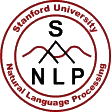Natural language processing (NLP) is one of the most important technologies of the information age. Understanding complex language utterances is also a crucial part of artificial intelligence. Applications of NLP are everywhere because people communicate most everything in language: web search, advertisement, emails, customer service, language translation, radiology reports, etc. There are a large variety of underlying tasks and machine learning models behind NLP applications.
Recently, deep learning approaches have obtained very high performance across many different NLP tasks. These can solve tasks with single end-to-end models and do not require traditional, task-specific feature engineering.
In this winter quarter course students will learn to implement, train, debug, visualize and invent their own neural network models. The course provides a thorough introduction to cutting-edge research in deep learning applied to NLP.
On the model side we will cover word vector representations, window-based neural networks, recurrent neural networks, long-short-term-memory models, recursive neural networks, convolutional neural networks as well as some recent models involving a memory component.
Through lectures and programming assignments students will learn the necessary engineering tricks for making neural networks work on practical problems.
This course is a merger of Stanford's previous cs224n course (
Natural Language Processing) and cs224d (
Deep Learning for Natural Language Processing).
FAQ
Can I follow along from the outside?
We'd be happy if you join us! We plan to make the course materials widely available: The assignments, course notes and slides will be available online. However, we won't be able to give you course credit.
Are the lecture videos publicly available online?
Update as of July 2018: Though we hoped to make the 2018 lecture videos publicly available, unfortunately we were unable to secure permission to do so. However, you can watch the
2017 lecture videos on YouTube, and we are actively trying to arrange to make the 2019 videos publicly available.
Can I take this course on credit/no cred basis?
Yes. Credit will be given to those who would have otherwise earned a C- or above.
Can I audit or sit in?
In general we are very open to sitting-in guests if you are a member of the Stanford community (registered student, staff, and/or faculty). Out of courtesy, we would appreciate that you first email us or talk to the instructor after the first class you attend. Due to high enrollment, we cannot grade the assignments or final projects of any students who are not officially enrolled in the class.
Can I work in groups for the Final Project?
Yes, in groups of up to three people.
I have a question about the class. What is the best way to reach the course staff?
Stanford students please use an internal class forum on
Piazza so that other students may benefit from your questions and our
answers. If you have a personal matter, email us at the class mailing
list cs224n-win1718-staff@lists.stanford.edu.
As an SCPD student, how do I make up for poster presentation component?
For the final poster presentation you can submit a video via youtube about your project.
As an SCPD student, how do I take the midterm?
For the midterm, we can use standard SCPD procedures of having your manager or somebody at your company monitor you during the exam.
Will there be virtual office hours for SCPD students
All office hours will be accesible on google hangouts. The link to the hangout is available on piazza


